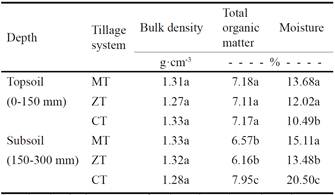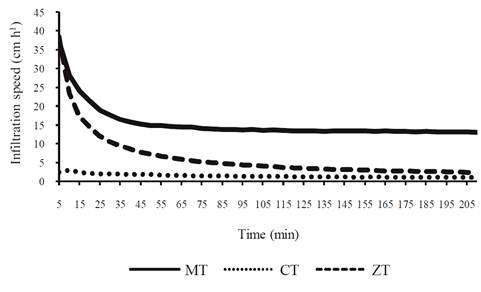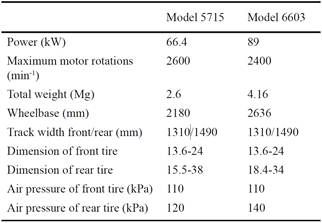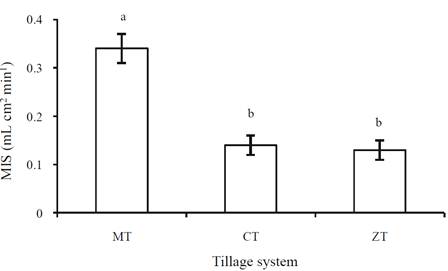Introduction
Soil compaction is regarded as the most serious environmental problem caused by conventional agriculture. Most of the common operations used in intensive maize cropping (tilling, harvesting, spreading of chemicals or fertilizers), are performed by wheeled farm machinery. In such operations, the soil is compacted by the load of the tractor and the coupled machinery. The overuse of wheeled farm machinery reduces pore space, resulting in a dense soil with poor internal drainage and reduced aeration, which leads to increased soil strength and particularly impedes root growth (Moullart, 1998; Bayhan et al., 2002; Hamza and Anderson, 2005). Poor internal drainage leads to run-off on the soil surface of ten producing edaphic erosion, resulting in fertility loss and diminished water apportion to the soil (Sarukhán and Maass, 1990; Osuna and Padilla, 1998).
Infiltration speed is considered a key indicator of soil quality (Weixelman et al., 1996; Arshad and Martin, 2002). It is explained as the process that defines the entrance and movement, vertically in general, of water through the soil profile in a unit of time (Tamhane et al., 1978; Porta et al., 1994; Cerdá, 1996). Infiltration speed is affected by the characteristics of the edaphic profile, such as texture, structure, organic and inorganic materials quantity, as well as size and total volume of pore space (Tamhane et al. , 1978; Gurovich, 1985). Buol et al. (1991) and Porta et al. (1994) recognize some subdivisions in the process ofinfiltration in the soil. They characterize the concept ofinstantaneous infiltration speed as the volume of water that infiltrates through a unitary horizontal soil profile in an infinitely small period of time. Also, these authors identify the basic infiltration speed as the constant rate registered in a soil after a testing period comprehending assays with duration of 3-4 hours.
Most research in soil compaction is concerned with its effect on crop yield and operating costs. In a hydrological context, many studies have dealt with the effect of soil compaction on soil hydrological properties (van Dijck and van Asch, 2002). However, few studies are concerned with the assessment of soil compaction using infiltration speed, specifically in the Vertisol soil characteristic of the maize producing area of the Toluca-Atlacomulco Valley in central Mexico. The aim of this research was to examine the effect on infiltration speed and penetration resistance of a Vertisol soil when compacted by wheeled agricultural traffic in three different types of tillage systems.
Materials and methods
This study was conducted on a 0.25 ha area of the experimental field of the Facultad de Ciencias Agrícolas de la Universidad Autónoma del Estado de México, in Toluca, State of Mexico, Mexico (19° 24' 43'' N, 99° 41' 40'' W, 2609 m.a.s.l.). The soil was classified according to the USDA Soil Taxonomy System, as a Vertisol, suborder Uderts, great group Pelluderts and subgroup Entic Pelluderts. The experimental area was used for wheat, oat and maize rotation under conventional tillage for more than 10 years. The different tillage systems were established on site during 2008 and 2009 to study the effects of tillage and other production techniques on maize cultivars and soil and water quality.
The study included the following tillage systems and traffic applications:
Conventional tillage (CT); multiple passes with a disc plow (model 635, two-wheel drive tractor, John Deere 5715), harrowing, sowing and fertilization combined.
Minimum tillage (MT); five passes, one with a multi-plow (model M-250, using a four-wheel drive tractor, John Deere 6603), three passes of harrowing and one of sowing and fertilization combined (two-line sowing implement, Sembradora del Bajío).
Zero tillage (ZT); one pass comprising sowing and fertilization (two-wheel drive tractor, John Deere 5715).
Some specifications of the tractors used for the agricultural operations are provided in Table 1. The experimental design consisted of a randomized complete block arrangement with three replications of the tillage systems, resulting in nine plots of 12.8 × 10 m including 16 rows with 0.8 m ofinter-row distance; plots were separated from one another by an 8 m wide traffic maneuvering area. For all systems, soil samples were obtained from the topsoil (0-150 mm) and subsoil (150-300 mm) horizons before tillage operations to evaluate moisture (M , gravimetric %), bulk density (BD , g cm-3) and total organic matter content (TOM , %). The M and BD were determined using the methods proposed by Landeros and Serrato (2001); the TOM was estimated using the AS-07 test (NOM-021-SEMARNAT-2000, 2002).
Two types of measurements were used to assess soil compaction in the tillage systems after all traffic operations were completed: penetration resistance (Pr ) and mean infiltration speed (MIS ). M levels in the topsoil and subsoil for all tillage systems at this stage ranged between 56-58%. The Pr was measured, with three repetitions for each plot, on the wheel track with a portable digital penetrometer (Field Scout SC-900, Spectrum Technologies, USA) with a cone angle of 60°, in a depth range of 0-30 cm. The penetration tests were hand-driven with velocities varying between 2 and 3 cm s-1. The MIS was determined according to the double cylinder infiltrometer method proposed by Anaya (1977) and considering the modified formula of Porta et al. (1994).
where: V is water volume (mL), A the inner cylinder area (cm2) and t infiltration time (min).
The obtained data were statistically analyzed by an analysis of variance (ANOVA) using SAS software (Statistical Analysis System, USA). All of the parameters were analyzed with a minimum of three repetitions and tested for significance (P ≤ 0.05) between the systems. When significant differences were found, the Tukey test was used to determine the difference among the means.
Results and discussion
Soil Properties of Experimental Site
The BD values before the tillage operations were similar in all of the tillage systems and at both depth levels (Table 2). The values obtained for BD were slightly higher than those reported by Casado and Valencia (2004) for a representative soil horizon of the experimental field and were indicative of similar soil compaction levels throughout the entire experimental area as a result of continued conventional tillage. Similar topsoil contents of the TOM were also found for all the systems. At the subsoil level, CT reported the highest TOM value compared with MT and ZT, with an average content increment of 25% respective to those systems (Table 2). Similar topsoil contents of TOM in the three tillage systems showed that since the establishment of MT and ZT in the experimental area (two years), the use of the multi-plow in the MT system did not efficiently incorporate the maize stover of the 2009 and 2010 crop cycles at different depth levels, and that for the ZT plots, the stover remained on the surface as mulch. The TOM was found to be higher in the CT subsoil than in the subsoil of the other systems due to the incorporation of organic matter from the previous crop cycle by the primary tillage operation of the disc plow. The M at the topsoil level was found to be lower in CT than in the other systems (23% lower on average); however, CT also reported the highest value in the subsoil (44% higher on average). The highest M value of CT in the subsoil horizon could be explained by the TOM content retaining soil water (Hamza and Anderson, 2005).
Table 2 Soil properties for minimum tillage (MT), zero tillage (ZT) and conventional tillage (CT) plots of the experimental area1.

1Each value is the average of at least three observations; the means within the columns followed by different letters are significantly different (P ≤ 0.05) by the Tukey's test. The mean comparison between horizons was made in an independent manner.
Penetration Resistance
Agricultural wheeled traffic did not increase Pr in the topsoil (Figure 1). This is not consistent with the results obtained by Botta et al. (2008), who showed that the pressure exerted by tractor passes results in a greater increase of topsoil cone index values (as a measure of soil strength) compared to the subsoil levels. The higher Pr values reported for MT at 15 cm depth may be explained by the use of multi-plow equipment producing less fragmentation of the surface soil than the disc plow. Average Pr in the depth between 5 and 15 cm for ZT was higher than that of the other treatments, but peak values were obtained for CT at 30 cm depth. This confirms the report of Benito et al. (1999), who found Agricultural wheeled traffic did not increase Pr in the topsoil (Figure 1). This is not consistent with the results obtained by Botta et al. (2008), who showed that the pressure exerted by tractor passes results in a greater increase of topsoil cone index values (as a measure of soil strength) compared to the subsoil levels. The higher Pr values reported for MT at 15 cm depth may be explained by the use of multi-plow equipment producing less fragmentation of the surface soil than the disc plow. Average Pr in the depth between 5 and 15 cm for ZT was higher than that of the other treatments, but peak values were obtained for CT at 30 cm depth. This confirms the report of Benito et al. (1999), who found that soil compaction was less with traditional tillage but compaction in the subsoil was greater than with the no-tillage treatment.
Mean Infiltration Speed
Higher basic infiltration rates for MT (Figure 2) can be attributed to the use of multi-plow equipment producing more fragmentation at higher depths. ZT and CT basic infiltration speed values are lower than those for Vertisol soils (5.38 cm h-1) with 1.2 g cm-3 of BD under conventional and zero tillage. The highest MIS value of MT (Figure 3) could be explained by the higher water infiltration rates in a relatively strong soil structure caused by the multi-plow equipment activity, which confirms the results reported by Hamza and Anderson (2002; 2003), where the water infiltrates uncompacted soils much faster than massive, structure-less soils.

Figure 2 Infiltration speed curves for minimum tillage (MT), conventional tillage (CT) and zero tillage after tractor operations and 58% of soil moisture.
Conclusions
With the experimental conditions proposed in this study, the following is concluded:
The pressure exerted by the number of wheeled traffic passes caused an increase in soil compaction at the subsoil level in a Vertisol soil, according to the Pr test.
The principal benefit of multi-plow use in reducing soil compaction during this time period (two years) can be appreciated by greater water infiltration, as MIS test suggests.
In most cases, the benefits of zero tillage were similar to those of minimum tillage during the experimental period.











 nueva página del texto (beta)
nueva página del texto (beta)






